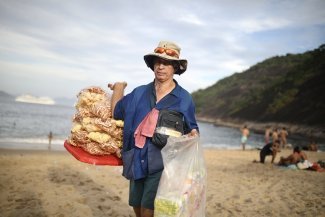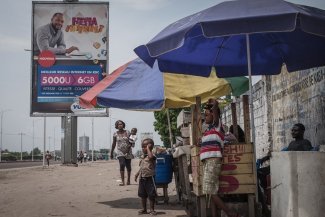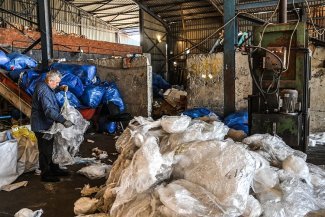Shaila Shikrant, 38, sat in the shade of her small house with her neighbours around her, filling bowls with rice, wheat, corn, peas, peanuts, sesame, chickpeas, lentils and fenugreek. They represent a small revolution, since she grew them herself.
Shikrant lives in Masla, a village of 800 households in the Marathwada region of Maharashtra state, 500 kilometres from Mumbai. Marathwada has had extreme heatwaves and faces a severe agricultural crisis, as repeated droughts and chronic debt have driven many farmers to suicide in the last few years. This is a nationwide problem: every year since 2013, some 12,000 farmers across India have killed themselves, according to government figures submitted to the supreme court in 2017.
There has also been a failure of agricultural strategy over the last decade, as food crops have gradually been abandoned in favour of cash crops such as sugar cane, which is more profitable but needs a huge volume of water. The government says the area in Marathwada under sugar cane cultivation grew from 300,000 to one million hectares between 2004 and 2014, taking 70 per cent of the region’s irrigation water. Shikrant said: “We had five hectares of land, and that was all we grew. So when we ran short of water, we lost everything – we had no money to eat.” She rubbed the pulses gently to shell them.
The other women listened attentively; since the wave of suicides in 2014, they have all followed Shikrant into sustainable agriculture.
“I asked my husband to let me have one hectare where I could grow crops that didn’t need so much water. I wanted to have something to feed my family in case the cane crop failed, and I wanted to go back to traditional methods, using natural fertilisers. He was sceptical at first, but in the end, he agreed. And when he saw the results, a year later, he let me have half of our land.”
The crops soon exceeded Shikrant’s expectations. She was able to feed her family, and selling the surplus doubled the family’s annual income, which is now US$7,500, while the average income for farmers in the region is US$2,000. She has continued to diversify, buying livestock, which provides fertiliser, and selling organic seed in Mumbai. Her latest achievement is registering her agricultural enterprise: “It’s all in my own name.” Her neighbours admire her, and thanks to her advice, have gained new status in their own families.
One woman couldn’t quite believe it: “When we told our husbands and our in-laws that we wanted to manage some of the land, they laughed at us. But now we earn more than they do, and they look at us quite differently.”
In Maharashtra and across India, women are more than 50 per cent of the agricultural workforce, but men are in charge, owning nearly 80 per cent of all cultivated land. Shikrant and friends decided to challenge this tradition, and they are not alone. According to the NGO Swayam Shikshan Prayog (self-education for empowerment, or SSP), 40,000 women amongst the 2.3 million rural households in Marathwada have taken charge of at least one hectare of land to grow food crops.
At the start, some received training from the Indian government’s Agricultural Technology Management Agency, in collaboration with NGOs such as SSP. But the movement has become self-propagating through the creation of thousands of women farmers’ groups, mutual aid organisations whose members pool their expertise and part of their savings. By setting up as market gardeners in Uttar Pradesh or rice farmers in Tamil Nadu, women have become pillars of local development across India. They have increasing support from universities, NGOs and local government bodies.
Women reshaping the local economy
In the village of Chiwri, 40km from Masla, the DeltaSakhi Farmers’ Group managed to save more than US$1,600 in a joint bank account in less than two years. This is a great advantage for the 25 members, whose husbands used to borrow from pawnbrokers at interest rates of up to 12 per cent. Now, when the women need cash for a project, they can turn to the group, which is able to secure a loan from a local bank. The moneylenders have shut up shop.
“Men are more individualistic: they all work their own fields, alone, but we operate as a team,” said Vanita Balbhim, chair of DeltaSakhi, who was hosting a weekly meeting of the group at her home. “And we’re better with money,” said Lakshmi Brirajdar. “We haggle over 10 rupees [US$0.15] if we need to. And if we are thirsty, we drink tea at home, instead of wasting money on alcohol.”
Chiwri is linked to the outside world by a rough earth track, used by herds of skinny zebu cattle, between empty fields that stretch to the horizon. Amongst the tin-roofed houses are a Hindu temple, a catechu tree under which the older people sit, and a little building with no doors where children can be heard chanting the alphabet.
In such remote villages, where 30 per cent of households live below the poverty line, women farmers’ groups are reshaping the local economy, securing food self-sufficiency and access to microfinance, key assets in times of crisis.
Since Balbhim began growing organic fruit and vegetables two years ago, she has been able to feed her family and add more than US$1,200 to their US$970 annual income. She has made enough to put a new roof on the house, buy a refrigerator and pay for the education of her four daughters. The eldest, Supriya, who is studying IT, said: “I’m so proud of her. She decided to get out of the house and work on her bit of land, and now she’s the head of a farmers’ group. No woman round here had ever done that.”
A huge migration of men to cities means women are increasingly important in agriculture, though they are not recognised as farmers in their own right. Soma Parthasarathy, a founding member of Mahila Kisan Adhikaar Manch (Makaam), a network of organisations campaigning for women farmers’ rights, said: “In practice they are already in charge, whether their husbands have gone off to the city to find work, or have died. But they have no legal status, so they don’t have access to the necessary resources – bank loans, insurance and government subsidies.”
A 2005 amendment to the Hindu Succession Act gave women an equal right to inherit parental property, but is still not widely applied. “Social conditions haven’t changed much: girls rarely claim their share of an inheritance – they’re encouraged to give it to the men in their family. We are still living in a patriarchal society, where men control the resources so as to be able to control women. We need to do much more to prevent them from doing that.”
Makaam is pressing, with Oxfam, for the adoption of a bill submitted in May 2012 to the upper house of India’s parliament by Monkombu Sambasivan Swaminathan, father of India’s ‘green revolution’. This would allow municipal authorities to give women who rent and work land recognition as farmers, and would invalidate property deeds that do not mention the name of the holder’s wife. Women farmers from across India, including many widows of farmers who had committed suicide, repeated this demand at a big demonstration outside parliament last November.
“Every disaster is an opportunity to move forward”
The emancipation of rural women is advancing at different rates in different states. In regions where the agricultural crisis has driven men to seek work in the cities, or kill themselves, it is seen as essential. At her office in Osmanabad in Maharashtra state, Naseem Shaikh, a project leader at SSP, said: “Every disaster is an opportunity to move forward: The long periods of drought have given women a chance to show their families that they can be leaders.”
For the last three years, SSP has mediated between local government and women farmers’ groups, helping them access training and subsidies. “The work women are doing speaks for itself: when the money starts to come in, it gives them bargaining power. Opening a bank account and buying a bit of land follow on naturally – we don’t have to force things.”
Anup Shengulwar, a senior local government official, said: “In terms of numbers of women owning land, we are still lagging behind some of the southern states, such as Telangana or Andhra Pradesh, but things are changing. We have suffered a great deal from drought here. Men are losing interest in farming, but women still want to work the land. So we are trying to train them. And we have already seen a rise in the standard of living in our villages.”
A third of the women farmers SSP has counted now own part of their family’s land and, importantly, have gained social recognition.
“Before, nobody respected me,” said Rekha Shinde, from the village of Hinglajwadi. “If I wanted 10 rupees, I had to plead for five days, and I wasn’t allowed to leave the house. Now, I bring home 10,000 rupees [US$155] a month, and I’ve helped 40 women set up their own businesses.”
A sign of their new importance is that the mutual aid group she leads now has its own meeting room, built by the village council.
Men may have benefited the most: there have as yet been no reported suicides in households where women have taken charge. Vishnu Kumbhar said: “In the past, I felt really alone during droughts.” His wife, Kamal, who earns over US$870 a month and has won a national award for micro-entrepreneurship, is a celebrity in Osmanabad district. The daughter of a day labourer, she grew up in poverty, but has turned six hectares of land on the outskirts of Hinglajwadi into an experimental farm, and drives to work on a moped. The farm has its own water reservoir, an electric incubator, and a pond for growing duckweed to feed livestock. She is never short of ideas: her latest gamble is 500 Kadaknath chickens, a breed valued for its high nutritional value, imported from Madhya Pradesh.
A crowd of children watched as she fed them. Khumbhar smiled as he looked at his wife, and said: “Now I take her advice. With my support, I believe there’s no limit to what she can do.”









